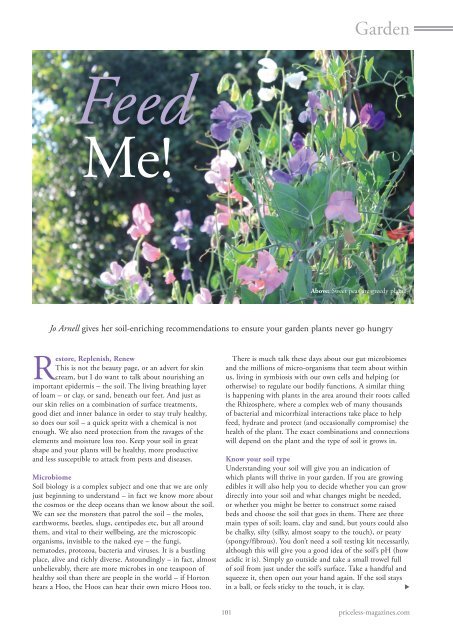Wealden Times | WT226 | March 2021 | Interiors supplement inside
Wealden Times - The lifestyle magazine for the Weald
Wealden Times - The lifestyle magazine for the Weald
Create successful ePaper yourself
Turn your PDF publications into a flip-book with our unique Google optimized e-Paper software.
Garden<br />
Feed<br />
Me!<br />
Above: Sweet peas are greedy plants<br />
Jo Arnell gives her soil-enriching recommendations to ensure your garden plants never go hungry<br />
Restore, Replenish, Renew<br />
This is not the beauty page, or an advert for skin<br />
cream, but I do want to talk about nourishing an<br />
important epidermis – the soil. The living breathing layer<br />
of loam – or clay, or sand, beneath our feet. And just as<br />
our skin relies on a combination of surface treatments,<br />
good diet and inner balance in order to stay truly healthy,<br />
so does our soil – a quick spritz with a chemical is not<br />
enough. We also need protection from the ravages of the<br />
elements and moisture loss too. Keep your soil in great<br />
shape and your plants will be healthy, more productive<br />
and less susceptible to attack from pests and diseases.<br />
Microbiome<br />
Soil biology is a complex subject and one that we are only<br />
just beginning to understand – in fact we know more about<br />
the cosmos or the deep oceans than we know about the soil.<br />
We can see the monsters that patrol the soil – the moles,<br />
earthworms, beetles, slugs, centipedes etc, but all around<br />
them, and vital to their wellbeing, are the microscopic<br />
organisms, invisible to the naked eye – the fungi,<br />
nematodes, protozoa, bacteria and viruses. It is a bustling<br />
place, alive and richly diverse. Astoundingly – in fact, almost<br />
unbelievably, there are more microbes in one teaspoon of<br />
healthy soil than there are people in the world – if Horton<br />
hears a Hoo, the Hoos can hear their own micro Hoos too.<br />
There is much talk these days about our gut microbiomes<br />
and the millions of micro-organisms that teem about within<br />
us, living in symbiosis with our own cells and helping (or<br />
otherwise) to regulate our bodily functions. A similar thing<br />
is happening with plants in the area around their roots called<br />
the Rhizosphere, where a complex web of many thousands<br />
of bacterial and micorrhizal interactions take place to help<br />
feed, hydrate and protect (and occasionally compromise) the<br />
health of the plant. The exact combinations and connections<br />
will depend on the plant and the type of soil it grows in.<br />
Know your soil type<br />
Understanding your soil will give you an indication of<br />
which plants will thrive in your garden. If you are growing<br />
edibles it will also help you to decide whether you can grow<br />
directly into your soil and what changes might be needed,<br />
or whether you might be better to construct some raised<br />
beds and choose the soil that goes in them. There are three<br />
main types of soil; loam, clay and sand, but yours could also<br />
be chalky, silty (silky, almost soapy to the touch), or peaty<br />
(spongy/fibrous). You don’t need a soil testing kit necessarily,<br />
although this will give you a good idea of the soil’s pH (how<br />
acidic it is). Simply go outside and take a small trowel full<br />
of soil from just under the soil’s surface. Take a handful and<br />
squeeze it, then open out your hand again. If the soil stays<br />
in a ball, or feels sticky to the touch, it is clay.<br />
<br />
101 priceless-magazines.com


















